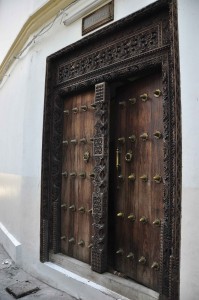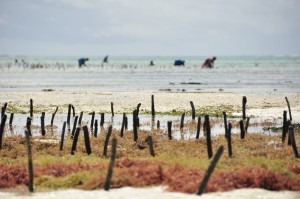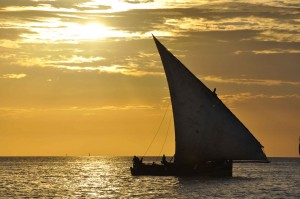The spice islands of the Zanzibar archipelago, our last stop in East Africa, promised a great chance to relax and with its heat and Muslim population, a perfect transitional base for our next move to the Middle East. Located a couple of hours off the coast of Dar es Salaam, Zanzibar is one of those words that just seems to command thoughts of the exotic and mysterious. It is a place steeped in a complicated history, trade here dates back several thousands years. At various times it has been a hub for Persian, Arabic, Indian, British, Portugese and Omani trade. Famed for its spices and as an epicentre for the African slave trade, the sultans of Oman used this as the location for their palaces and centre of government as recently as the turn of the 20th century.
Arriving early morning on the ferry from Dar the first place you encounter is Stonetown. A pretty warren of whitewashed stone houses, cobblestone streets, craft shops, forts and palaces, it is a magical setting. From the beach and waterfront Dhow boats sail in all directions, while the doors of many of the houses here are intricately carved works of art and hundreds of years old. Both provide tangible hints to the islands past, traditions and history. We have actually decided to spend a few days here right before our departure, so we jump a ‘dallah dallah’ (an open sided truck version of a mini-bus) and head across the island to the East Coast, Jambiani.
Jambiani is a quiet village that extends several kilometres along one of the best beaches in Zanzibar so we have read. Our first destination is a lodge that we had heard about from most Japanese long term travellers we had met that had stopped through here. Malaika is a small, cheap guesthouse that Japanese seem to love not just for the price (it is the cheapest place by a mile), but for the food. Somewhere along the way the villager who runs this place has not only learn’t Japanese but more importantly how to cater to the Japanese stomach and sure enough when we arrive there are 3 other Japanese solo travellers there. The rooms are simple, no electricity, extremely basic bathrooms but board comes with dinner and breakfast. We dump our bags and head off to explore the beach, only to find that the water was lapping on the edge of the houses that line the waterfront, a little surprised we retreat to the village instead and spend a few hours wandering the thin strip that is the town.
Everyone is friendly here, Swahili greetings of Jambo (hello), Habari (How are you?) and Karibu (Welcome) echo around us in all directions; old men, play board games in fenced, seated areas beneath tree’s in the afternoon shade, kids chase us down the street so that they can hold our hands and for the first time in as long as I can remember no-one is trying to sell us something! Paradise indeed! The biggest industry in this part of Zanzibar (apart from tourism) seems to be seaweed. Just about every house has a pegged square of the stuff drying. I had read that Japan was one of the huge export markets for this stuff, but it was fascinating to see. As the afternoon grew long, the water receded and a thin beach reassuringly began to appear, so we walked along it looking at the various waterfront options trying to find somewhere to stay longer term. As nice as the food at Malaika might be, no electricity was a bit of an issue and it simply didn’t have the appeal of a 4 day stay. It is low season at present, so most of the hotels and beach escapes are closed or hadn’t seen customers in weeks, making it easy enough to negotiate pretty decent rates. After a few exploratory enquiries, we stumbled upon a bright, funky place called “Starfish”, run by a community of young friendly rasta’s with a constant reggae flow. They had a standalone villa, beautifully appointed, cheap, with hammock and right on the beach just along from the restaurant / bar, all the furniture constructed out of old wooden boats. We struck a deal for tomorrow, got initiated into the ‘family’ and headed back for dinner. True to form, Malaika served up a Japanese fish style curry, accompanied by mountains of rice and tea. Megumi was well satisfied, even more so by the stack of Japanese books they had collected in the library. Post dinner we wandered down the beach to another rasta bar with the other Japanese travellers and received our biggest surprise. It seems we had arrived at high tide and during the dinner interval the water had receded almost 500 metres from shore, in the process stranding the hundreds of dhow boats on the sand and revealing large seaweed farms and a wide sandy beach – the white water of the waves now no more than a tiny spec in the distance.
Our plan was simply to relax and do nothing for 4 days here, catch up on some reading, some blogging & indulge ourselves in other such nothings. As we moved into Starfish the next day we realized we couldn’t have chosen a more apt setting. The oceans daily transformations became the most hypnotic backdrop imaginable. With the ebb and flow of the tide, the entire village appeared, tending their seaweed farms in the morning, going fishing and hauling seaweed back to the shore. You could literally wade out ankle deep for half a kilometre amongst the farms, boats and villagers. Then as the tide came in early afternoon everyone retreated, the ocean a clean, turquoise blanket discreetly hiding all evidence of the labour. The evenings waves washing in with them a huge assortment of seaweed and shells, pickings for the early morning villagers to clean up, sort through and farm out for valuables.
After a hectic several months, we hadn’t really had a chance to relax or reflect much on our travel to date. Kenya aside, Africa had been a constantly moving feast, with little respite for contemplations, as had our last days in India truth be told. Here, seemingly in a village devoid of tourists or agenda, the space finally revealed itself and in tune with the villagers magnetic daily routines, the thoughts flowed.
To be honest, I had little expectations in Africa. India / Nepal, the Middle East and South America were all my key destinations when we set out. Africa was kind of a Megumi indulgence, seduced by the animals she so loves and the chance to tick off another continent in our adventure. It was a surprise packet really, an unknown and after almost 3 months here I wouldn’t have had it any other way. Certainly there are a few places I would have loved to have gotten the chance to explore and allocated more time to – Uganda first and foremost, but also Botswana and some countries in the West Coast (Senegal, Ghana). Had we known more, we probably wouldn’t have flown to Egypt either, but rather tried overlanding through Ethopia and the Sudan. Yet everywhere we go, we have such compromises to make.
The endearing sense of the African continent is similar to my own feelings about Australia in many ways, though very different in others. Nature inspires here and is the dominant driving force of the land, everything subordinate; yet whereas the harshness of the Australian condition results in nature achieving numerous harmonious niches, Africa is different this way. It has a raw Darwinian feel to it – it’s all ‘survival of the fittest’, top of the food chain stuff here, something that extends to both its animals and its tribal conflicts among the people. Life is incredibly cheap here and only the strong survive.
With a few rare exceptions; civilization and the cities don’t really offer that much in the ways of an experience in Africa. There is little to learn from most of the continents epi-centres, tending simply to be a place for the masses to try their luck at escaping the cycle of poverty. Crime, violence and desperation seem to increase exponentially with the population, but perhaps that could be said of most places in the world outside Japan. It is only out in the countryside, the villages and stunning expanse of the natural environment that Africa impresses. My abiding memories will be those of the safari’s, hikes and bus rides – immersions amongst both people and animals, totally unique experiences in the context of our global adventures.
The other thing that stands out unfortunately is the expense. Africa is not cheap and tragically not suited to the budget traveller. All the good things here cost serious money and they are really the things you want to do. In many places prices are anchored in US dollars, manipulated by corrupt, self serving governments and feel extortionate relative to the poverty of the surrounding people and villages. There is rarely a middle ground. It would not be a problem if it felt like the money was going to the community but this is rarely the case. Asia and other great tourist destinations do not work this way, they tend to embrace their exchange differences as a key attraction, catering to all the market segments and opportunities. In the desperate grab for cash in this land, everyone has sold themselves short of the bigger picture and the chance to captivate more people with the African magic and bridge so many of the cultural and financial divides that simmer below the surface here. For this and other reasons, I am actually glad to be leaving. The time spent here has been magical, insightful and an experience that will live long in the memory – but it is comparative poor value for money. We are not constrained by student budgets as many of the travellers that we meet, but we also know we have other places where we would rather spend it. There are cheaper ways to see Africa though I think – buy a 4WD and camp or alternatively volunteer (though most people we have spoken to working this way, said they have not enjoyed the experience and likely would not come back). Perhaps we will revisit someday if I happen to trip and fall into a fat corporate salary; a limited travel window would tend to hide the sting a lot more effectively.
Until then, though, we have the Middle East to think about. And as I look out at the incoming tide, a whole new set of challenges seems to be washing in – burka’s, conservatism, ancient civilizations, no alcohol and insane heat, all balanced by a completely new raft of exotic delights. I can’t wait!
![Zanzibar Reflections The spice islands of the Zanzibar archipelago, our last stop in East Africa, promised a great chance to relax and with its heat and Muslim […]](http://meltingplots.com/wp-content/uploads/2010/05/ZanzibarTop.jpg)



